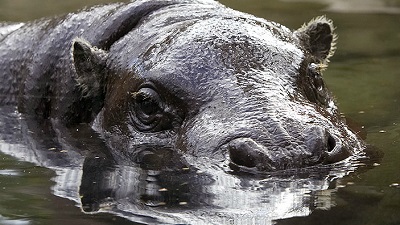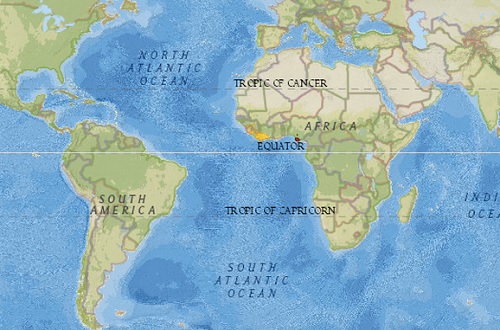Taxonomy
- Kingdom: Animal
- Phylum: Chordata
- Class: Mammalia
- Order: Artiodactyla
- Family: Hippopotamidae
- Genus: Choeropsis
- Species: Choeropsis liberiensis
o
o
0
Population
- The IUCN estimates a population of less than 3,000 individuals with a projected decline of 20% over the next 20 years.
Name
- Scientific name: Hexaprotodon liberiensis or Choeropsis liberiensis. Choeropsis from the Greek “having the appearance of a young pig” Liberiensis from the country Liberia where most of the distribution of pygmy hippos is concentrated.
- Common name: Pygmy Hippopotamus, pygmy hippo.
Physical Features
- Its skin is dark green to black on its back, fading to grey on the sides and grey white on its belly.
- Pygmy hippos have glands that secrete a brown-red liquid called “blood sweat” which protects the skin from the sun and prevents it from cracking.
- Pygmy hippos are smaller than common hippos (Hippopotamus amphibious), about half the size. Its legs and neck are longer and head smaller in relation to its body compared to common hippos.
- Pygmy hippos have less webbing in their feet than common hippos.
- The length of its tail is about 6.3 in (16 cm).
- Their stomach has four chambers which is an adaptation to poor quality high fiber diet.
Height and Length
- Pygmy hippos weigh from 352 to 606 lb (160 to 275 kg).
- Their body length ranges from 4.92 to 5.74 ft (1.5 to 1.75 m).
Distribution and Habitat
- Pygmy hippos are distributed mainly in Liberia. Smaller populations exist in Ivory Coast, Sierra Leone and Guinea.
- Pygmy hippos are semi-aquatic animals. Its habitat consists on forests and rainforests near sources of fresh water such as rivers, streams, lakes, ponds and swamps.
- Distribution of pygmy hippos (Choeropsis liberiensis) and common hippos (Hippopotamus amphibious) do not overlap.
Behavior
- Little is known about pygmy hippos in the wild. What is known about them has been observed in the captivity.
- Pygmy hippos spend the day in water or near water and on dry land hiding in swamps, wallows or rivers.
- They eat at night on land.
- They are solitary animals unless looking for a mate or raising their young.
- They rest in the same place for several days before moving to a different spot.
Diet
- Pygmy hippos are herbivores. Their diet consists on roots, leaves and fallen fruit including semi aquatic plants.
Reproduction
- Reproductive maturity is reached at 4 to 5 years of age.
- Breeding occurs throughout the year, there is no peak season.
- Gestation period is 188 days.
- Pygmy hippos give birth on land to one young, very rarely will they give birth to twins.
Life Expectancy
- The average life expectancy for pygmy hippos in captivity is 42 years.
Threats
- Habitat destruction and conversion have pushed pygmy hippos to smaller habitats.
- The Liberian civil war has had an effect on enforcing protection of pygmy hippos which are hunted for their meat.
Conservation Status
- Pygmy hippos are listed as an Endangered species by the IUCN Red List of Threatened Species.
- The species is listed under CITES Appendix I, under which its trade is prohibited.
- To protect pygmy Hippos Liberia established Sapo National Park and Ivory Coast Tai National Park.
References and further research
IUCN Red List of Threatened Species
ITIS Report – Hexaprotodon liberiensis
Zoological Society of London Pygmy Hippo Conservation
IUCN Red List of Threatened Species – Choeropsis liberiensis
World Association of Zoos and Aquariums – Pygmy Hippo (Choeropsis liberiensis)
University of Michigan Museum of Zoology – Hexaprotodon liberiensis
San Diego Zoo Library – Hippopotamus Fact Sheet


